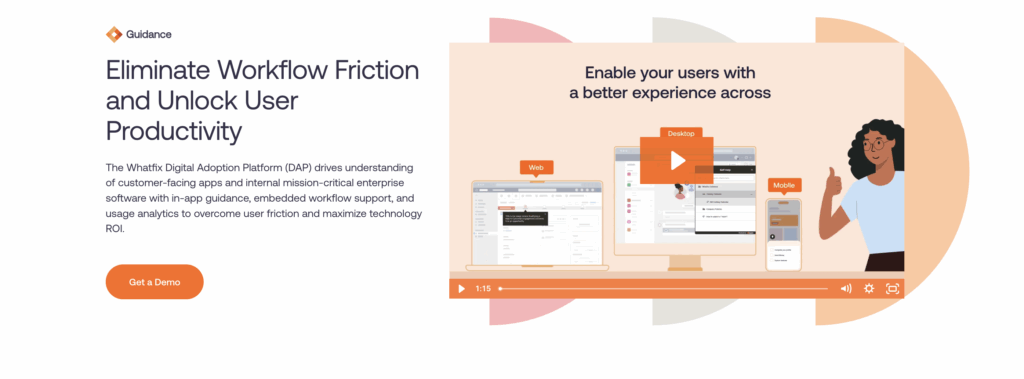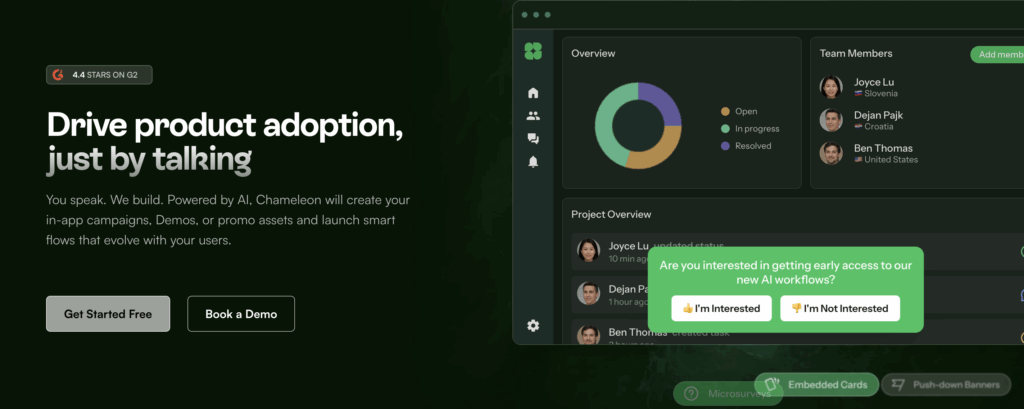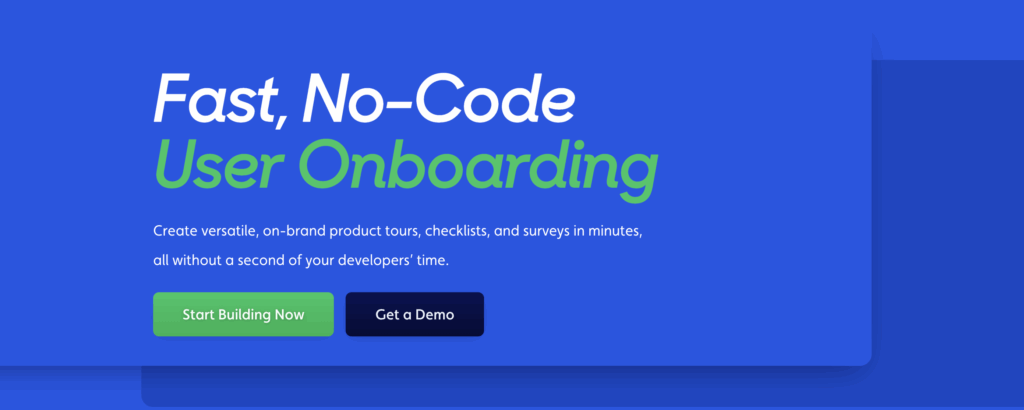
Imagine this scenario – You spend months building a feature. Your team pours heart and soul into the perfect solution. You hit launch…and crickets.
Less than 7% of users ever touch it. According to recent benchmarks, the median feature adoption rate hovers around 6.4%, which means that only about 6 out of every 100 features you ship actually drive meaningful usage.
That’s not a feature problem. It’s an adoption problem.
Nearly 30,000 new products hit the market each year, but 95% of them fail. The difference between products that thrive and those that die isn’t usually the quality of the feature itself – it’s whether users actually discover, understand, and integrate it into their workflow.
Think of product adoption like teaching someone to drive. You wouldn’t just toss them the keys and say “figure it out.” You’d guide them through each step, watch where they struggle, adjust your approach, and celebrate when they nail a parallel park. That’s exactly what adoption tools do for your product—they guide, diagnose, adjust, and optimize the path from “new user” to “power user.”
In this guide, we’ll break down the exact tools that measurably lift adoption. No fluff, no generic listicles – just the tools that actually move the needle.
Choose Product Fruits if: You’re a startup or mid-sized SaaS looking for the most cost-effective, all-in-one solution It offers AI-powered tours, onboarding checklists, feedback widgets, announcements, and an integrated knowledge base—no code required. Rated 4.7 on G2 for exceptional support and best value-for-money in the market.
Choose Appcues if: You want a mobile-first onboarding platform with a clean drag-and-drop builder and ready-to-use UI templates. Ideal for product teams prioritizing intuitive UX and quick deployment.
Choose Chameleon if: You need visually polished, hyper-customized tours and tooltips ($279+/month) with full on-brand control and advanced targeting rules.
Choose UserGuiding if: You want fast setup, pre-built templates, and simple pricing ($174+/month). Build checklists, tooltips, and modals without developers.
Choose Whatfix if: You’re an enterprise seeking localization, governance, and analytics at scale. Works across multiple web apps with strong change management support.
Choose Userflow if: You need fast deployment, high customization, and lightweight SDK performance. Setup can take under a day, ideal for agile teams.
Before we dive into tools, let’s get clear on what we’re actually trying to improve.
Product adoption isn’t just activation. Product adoption is the process by which people learn about your product and start using it to accomplish their goals—the “aha moment” when users start using your product for what you built it to do.
Here’s the distinction that matters:
User Activation is when users hit a milestone and experience value. Adoption happens when they completely embrace your product as their habitual solution.
To successfully measure your product adoption, here are the key metrics you should track to understand your product adoption:
The ratio of users who complete a specific set of actions or reach a predefined engagement level that signals they “get” your product. Calculate it as:
Activation Rate = (Users who hit activation milestone / Total signups) × 100
The percentage of your user base actually using specific features. Remember that brutal 6.4% median? This is where you see if you’re beating it or drowning in it.
Feature Adoption Rate = (Users who engaged with feature / Total active users) × 100
The timeframe users take to derive maximum value from the product after initial interaction—essentially the timeline between signup and activation. The shorter, the stickier.
The DAU/MAU ratio —daily active users divided by monthly active users. A sticky product means users return habitually, not just occasionally.
A composite metric combining adoption, stickiness (DAU/WAU/MAU ratio), and growth to give you a single north-star view of product health.
Not all adoption tools are created equal. Each category solves a different piece of the puzzle. Think of them as different instruments in an orchestra—you need the right mix at the right time.
DAPs like Product Fruits are software layers integrated on top of applications to guide users through tasks and functions, helping businesses onboard new users with in-app guidance and tutorials.
Think tours, checklists, tooltips, in-app announcements, and resource centers—all created without writing a line of code.
So when do you use DAPs? Use DAPs when:
Imagine a SaaS product where only 15% of users complete setup. You add a checklist DAP that walks users through three must-do steps. Suddenly, 40% complete setup because they’re not lost in the UI wilderness.
A Product Analytics tool like Amplitude tracks user behavior to understand exactly which behaviors correlate with adoption revealing drop-off points, feature usage patterns, and paths to value.
So when do you use Product Analytics tools? Use them when:
Adoption is a better predictor of long-term metrics (like LTV or retention) than acquisition, because you can acquire thousands of customers, but if they never use the product, you’ll never meet long-term goals.
You wouldn’t perform surgery without an X-ray. Don’t deploy in-app guidance without analytics showing you where users struggle.
These tools deliver contextual nudges across in-app modals, email, and push notifications based on user behavior or cohort membership.
So when should you use a lifecycle and in-app messaging platform?
In-app messages crush email for immediate context. If someone’s staring at a feature they haven’t used, a tooltip right there beats a “Check out this feature!” email three days later. Tools like Product Fruits are great for doing this.
Use these tools to control feature rollouts using flags or toggles, gradually releasing updates to small user segments to ensure stability and minimize risks.
So when should you use a lifecycle and in-app messaging platform?
Feature flag tools enable teams to deploy features safely and efficiently while minimizing risks by decoupling code deployment from feature releases. Translation: Ship code hidden behind a flag, flip it on for a test group, measure impact, and roll back instantly if things break. No drama, no emergency hotfixes at 2 AM.
Show the performance of live in-app guidance and detect product optimization opportunities by recording user sessions, highlighting frustration signals (rage clicks, dead clicks), and surfacing console errors.
So when should you use a session replay and UX diagnostics?
Data tells you 60% abandon the checkout page. Replay shows you they’re clicking a disabled “Submit” button 11 times before giving up. Suddenly, you know exactly what to fix.
In-app feedback captures in-app micro-surveys, NPS, and feature requests at the moment of friction, then trigger follow-up guides or route responses to your roadmap.
So when should you use an in-app feedback tool?
User rates NPS as 4. Your DAP instantly shows them a guide to the feature they’re missing. Two weeks later, they’re a promoter. The best way to go about this is finding a tool that combines the power of in-app feedback with your DAP. So tools like Product Fruits are great for doing this if you want all that user data and interactions in one place.
Let’s get specific. Here are the tools that will actually help you increase product adoption, with honest takes on who they’re best for.
When should you choose Product Fruits?
Product Fruits stands out with AI-assisted onboarding that can auto-generate flows and improve microcopy. If you’re a lean team that needs professional tours without a full-time onboarding designer, this is your pick.
Who is Product Fruits Best for: Teams who want to ship onboarding fast, don’t have dev resources, and value AI speed boosts.
Learn more about Product Fruits →

Whatfix includes in-app walkthroughs, tooltips, task lists, nudges, and resource centers (13 Best Digital Adoption Platforms (DAPs) in 2025) and is built for global, complex enterprises.
When should you use Whatfix?
Who is Whatfix Best for: Enterprise-wide digital adoption, transformation, and change management (13 Best Digital Adoption Platforms (DAPs) in 2025) where you need SSO, approvals, and multi-language support.

Chameleon offers unique strengths in advanced analytics, ease of use, and personalized onboarding experiences (5 Best Digital Adoption Platforms I’d Pick for Faster Onboarding).
When should you choose Chameleon?
Best for: PLG SaaS companies that want design control and behavior-based targeting without compromise.

Appcues began as a product analytics platform and added in-app guidance for onboarding and engagement, popular with SaaS companies prioritizing product usage and customer feedback (13 Best Digital Adoption Platforms (DAPs) in 2025).
When should you choose Appcues?
Best for: Mid-market SaaS teams who value transparency and pre-built patterns.

Userpilot is best for product growth and digital adoption across web and mobile.
When should you choose Userpilot?
Best for: Series A–C companies scaling onboarding and feature adoption.

Userflow is best for implementing a straightforward digital adoption process.
When should you choose Uerflow?
Best for: Lean teams who need guides live this week, not next quarter.

| Feature/Platform | Product Fruits | Whatfix | Chameleon | Appcues | Userpilot | Userflow |
|---|---|---|---|---|---|---|
| Target Audience | SMB to mid-market SaaS | Global enterprises | PLG SaaS companies | Mid-market SaaS teams | Growth-stage SaaS | Lean teams needing rapid deployment |
| Key Features | AI-assisted onboarding, no-code tours, checklists, tooltips, announcements | In-app walkthroughs, localization, analytics | Highly customizable UX (tours, tooltips, surveys) | Mature onboarding flow templates, public pricing | Flows, checklists, in-app surveys, NPS | Fast setup of guides and checklists, strong theming |
| Best For | Teams needing fast onboarding without dev resources | Enterprise-wide digital adoption and change management | Design control and behavior-based targeting | Transparency and pre-built patterns | Scaling onboarding and feature adoption | Immediate deployment without delay |
| Customization Flexibility | Moderate | Moderate | High | Low | Moderate | High |
| Time-to-First-Guide | Fast | Moderate | Moderate | Fast | Fast | Very Fast |
| Localization Support | Limited | Strong | Moderate | Limited | Moderate | Limited |
| Analytics Integration | Basic | Yes (analytics + guidance combined) | Advanced | Yes | Yes | Limite |
Don’t buy on hype.
Look for:
Use this checklist.
1. Outcomes & measurement
Can the tool track and move feature adoption, time-to-value, and PES tied to your core events?
2. Targeting & personalization
3. Data strategy
4. Safety & governance
Effective feature management mitigates risks (The best feature management and experimentation software 2025 – LeadDev) through:
5. Performance, SDKs, localization, accessibility
6. Effort & time-to-first-value
Pro tip: Run a proof-of-concept focused on your core events. Don’t just trust demos—measure lift on real users.
TL;DR: Features don’t fail because they’re weak. They fail because users never reach value. If you want growth, optimize adoption, not just launches.
The fastest path is a layered stack:
Do this well and you’ll shrink time-to-value, raise feature adoption, and turn new users into power users.
Activation is a one-time milestone that proves initial value (e.g., first integration). Adoption is ongoing, habitual use where the feature becomes part of the workflow. Aim to optimize both, in that order.
Benchmarks hover around ~6–7% median for most products. “Good” is beating your own baseline by segment and steadily compounding: new feature → 14/30/60-day adoption → retained usage.
Reduce friction to first value. Use a DAP to add checklists, targeted tours, and tooltips; pair with analytics to remove blockers; nudge next-best actions with in-app messages; validate with experiments.
Use a DAP to guide users (tours, checklists, nudges) right now. Use analytics to find where and why users drop off, then measure whether the guidance worked. They’re complementary, not substitutes.
AI agents personalize onboarding, detect hesitation in real time, and offer context-aware help. They answer routine questions, route complex ones to humans, and learn which guidance drives completion and retention.
Product Fruits is a no-code DAP with AI-assisted onboarding, checklists, tooltips, announcements, and surveys. It’s ideal for SMB–mid-market teams that need to ship guidance fast and iterate without dev cycles.
Track: Activation Rate, Feature Adoption Rate, Time-to-Value (TTV), Stickiness (DAU/MAU), PES, and support ticket volume. Report lift vs. control cohorts and watch 14/30/60-day retention.
A 3-step checklist to first value, one targeted tour per must-do action, tooltips on tricky UI, and an in-app help hub with FAQs. Add a micro-survey at the biggest drop-off to capture “why.”
Run an experiment: expose 50% to the new onboarding. Show Δ TTV, Δ feature adoption, Δ retention, and ticket reduction. Convert gains to revenue (expansion + churn saved) minus tool cost.
Shipping tours without analytics, one-size-fits-all onboarding, long autoplay tours, no experiments, ignoring feedback, and treating adoption as a launch task instead of a weekly operating cadence.
With a no-code DAP, your first live guide/checklist can ship in days. Full coverage is iterative: start with the must-do path, then expand by segment and feature.
Look for SSO, audit logs, approvals, WCAG accessibility, SDK performance, and localization. If you’re global or regulated, prioritize these in your vendor short-list.